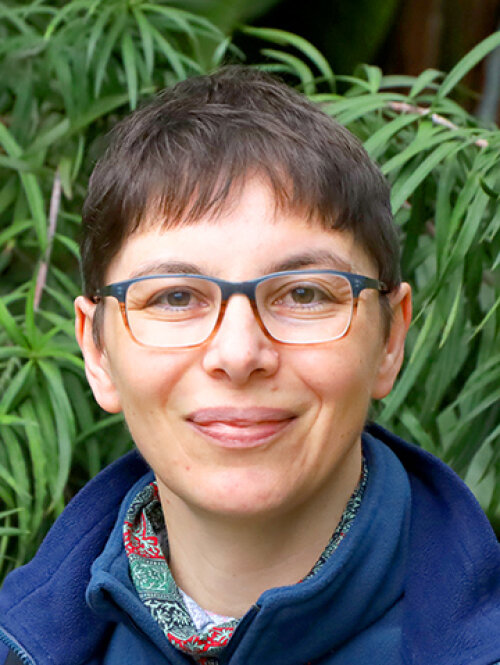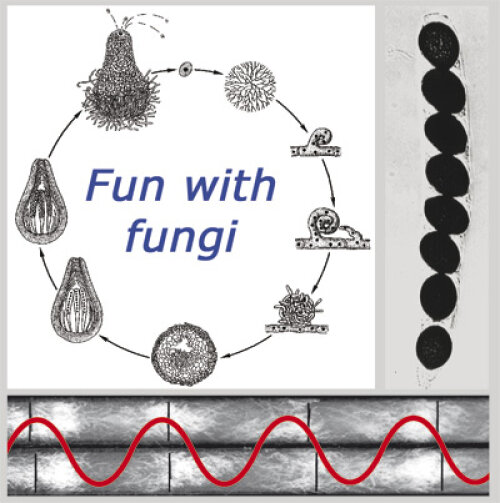
PD Dr. Minou Nowrousian
Lehrstuhl fuer Molekulare und Zellulaere Botanik
Fakultaet fuer Biologie und Biotechnologie ND 7/176
Ruhr-Universitaet Bochum
44780 Bochum
Germany
phone: +49 (0) 234 3224588
Besides research, I like photography (analog and digital) and you can see some of my pictures at http://portfolio.fotocommunity.de/portfolio-minou

Project group "Functional genomics of fungal morphogenesis" (principal investigator: Minou Nowrousian) at the Department of Molecular and Cellular Botany at the Ruhr-Universität Bochum.
Filamentous fungi grow in form of hyphae (elongated, branched cell filaments). They can aggregate to form complex structures, e.g. fruiting bodies in which spores are formed. We are interested in the genetic basis of these differentiation processes. To analyze how fruiting body formation is regulated at the molecular level, we use mutant strains that are blocked at different stages of development and compare gene expression in the mutants to that of the wild type using a combination of laser microdissection and RNA-seq, and quantitative real time PCR. Additionally, we compare gene expression in several fungal species to identify expression patterns that are evolutionary conserved (comparative functional genomics). Genes with similar regulation will help to define a core group of genes involved in fungal fruiting body development.
In a second project, we are studying the evolution of mating type genes in the Tremellomycetes, a group of basidiomycetes that contains many species that grow as yeasts (unicellular fungi). The ancestral state of basidiomycete mating type organisation in thought to be tetrapolar, i.e. each strain contains two non-linked (independently segregating) mating type loci. However, in a number of basidiomycetes, the two mating type loci became physically linked on the same chromosome. This arrangement is predicted to facilitate inbreeding, which might be an advantage if mating partners are hard to find, e.g. for pathogenic species in a host environment. We are currently focusing on the order Trichosporonales, where all strains analyzed so far contain physically linked mating type loci in an evolutionary conserved genomic arrangement.
Latest results from our projects:
Development of complex multicellular structures in ascomycetes:
We have compared the genomes and development-dependent transcriptomes of the three ascomycetes Ascodesmis nigricans, Pyronema confluens, and Sordaria macrospora to identify genes with conserved expression patterns during multicellular development. The Ascodesmis nigricans genome, which was sequenced during this study, is part of the 1000 Fungal Genomes Project. We identified 83 genes that are upregulated only during fruiting body development in all three species. Genes encoding proteins with predicted roles in vesicle transport, the endomembrane system, or transport across membranes as well as genes with predicted roles in chromatin organization or the regulation of gene expression comprise 23 and 13 of the upregulated genes, respectively. Functional analysis of four of those genes revealed that three are involved in fruiting body formation, with two of them encoding predicted chromatin modifiers.
In a follow-up study, we have functionally characterized the developmental genes asm2, asm3, and spt3 using fluorescence microscopy and transcriptomics. Deletion of spt3, which encodes a subunit of the SAGA complex, results in a block at an early stage of development and drastic changes in the transcriptome. Deletion mutants of asm2 and asm3 are able to form fruiting bodies, but have defects in ascospore maturation. Transcriptomics analysis of fruiting bodies revealed a large overlap in differentially regulated genes in the asm2 and asm3 mutants compared to the wild type.
Evolution of mating type genes in basidiomycetes:
In a collaboration with the laboratory of Joseph Heitman (Duke University, USA), we have analyzed the mating type loci of the Trichosporonales, a little-studied group of basidiomycetes. As it turned out, all analyzed Trichosporonales species have fused mating type loci; however, these mating type loci have different features compared to previously studied fused mating type loci in other basidiomycete groups. Both the gene sequences as well as the order of genes within the mating type loci are extremely conserved in the Trichosporonales, in contrast to fused mating type loci in other basidiomycetes, which often show degeneration.
In a collaboration with the laboratory of Dominik Begerow at the Ruhr-University Bochum, and as part of the 1000 Fungal Genomes Project, we have recently sequenced the genomes of two strains of the basidiomycete yeast Filobasidium floriforme. This species belongs to the little-studied order Filobasidiales, which branches basally to the Tremellales, Trichosporonales and Holtermanniales. The genomes of strains CBS6241 and CBS6242 are approximately 27 Mb in size, and were analyzed with respect to genes that are part of mating type (MAT) loci as well as CAZyme-encoding genes.